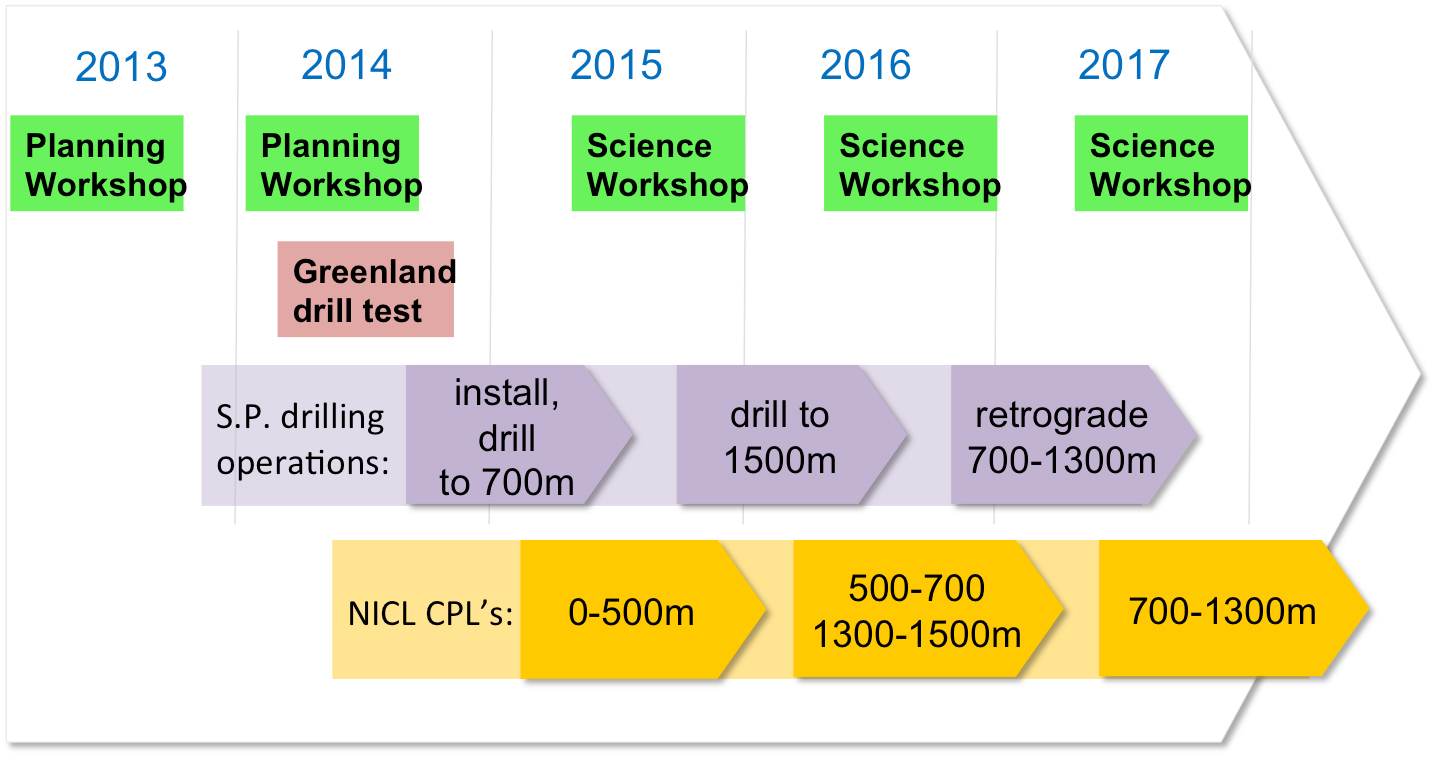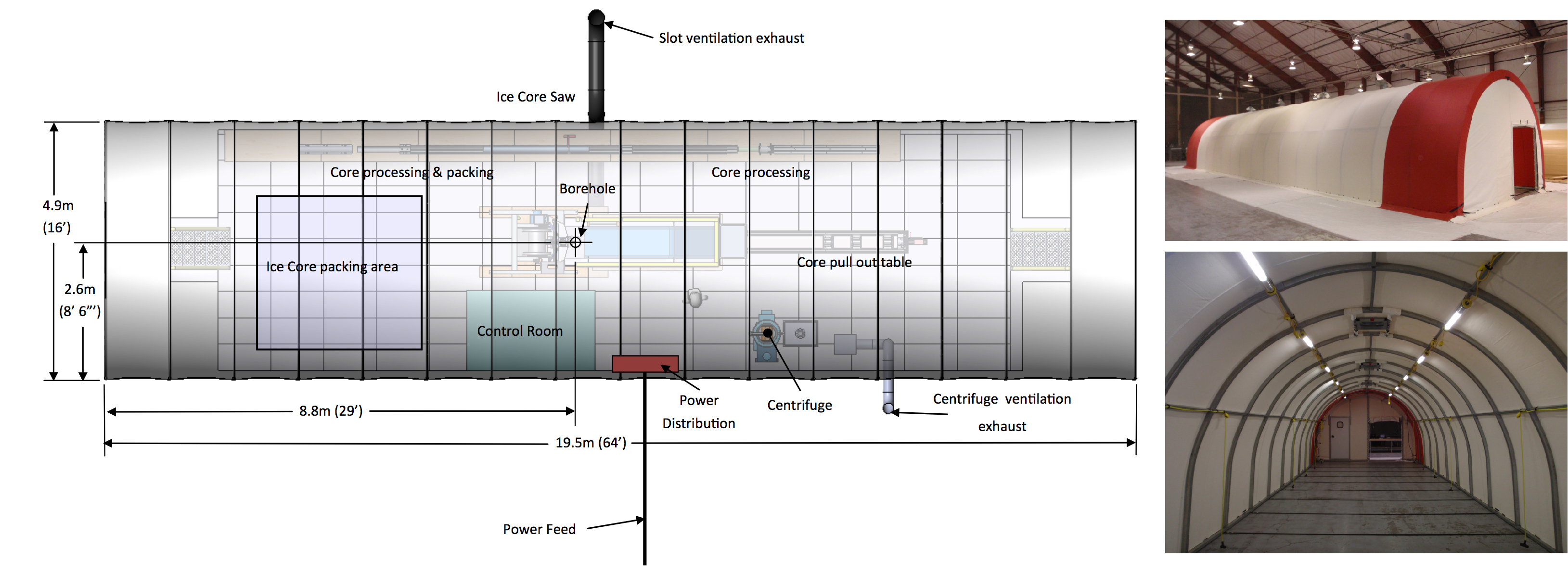
Project Overview
The South Pole Ice Core project is a U.S. effort funded by the National Science Foundation (NSF) to drill and recover a new ice core from South Pole, Antarctica. The ice core will be drilled to a depth of 1500 meters and provide records of stable isotopes, aerosols, and atmospheric gases spanning approximately 40,000 years. The South Pole site preserves unique climate records by combining cold temperatures typical of East Antarctica with a relatively high accumulation rate due to West Antarctic influence. The South Pole Ice Core extends the international array of ice cores used to investigate environmental change since the last glacial/interglacial transition. The scientific goal is to assess and understand changes in atmospheric chemistry, climate, and biogeochemistry. Drilling is planned for the 2014-2015 and 2015-2016 field seasons, and a new intermediate-depth drill will be used to recover the ice core.
Project Organization
With support from NSF's Division of Polar Programs, UC-Irvine (Saltzman–Lead PI and Aydin), University Washington (Steig) and the University of New Hampshire (Twickler and Souney) — with assistance from NASA-GSFC (Neumann) — provide the overall scientific coordination for the project, which includes site selection, field operations, core processing at the National Ice Core Laboratory, data management, and communications/workshops.
Logistical support is provided by NSF's Antarctic Research & Logistics Integration program and is managed by Leah Street with the Antarctic Support Contract (ASC). Drilling support is provided by the U.S. Ice Drilling Program and is led by Jay Johnson (drill development) and Tanner Kuhl (lead driller).
Site Selection and Preparation
During FFY 2013, Tom Neumann (NASA-GSFC), TJ Fudge (University of Washington) and Kimberly Casey (NASA-GSFC) led site selection activities using existing radar, accumulation, ice core, flow velocity, depth-age and surface elevation data. After reviewing the existing glaciological data, and after discussions with NSF and ASC regarding logistical considerations, a drill site for the South Pole Ice Core was established and approved by NSF in August 2013.
The drill site is in the Dark Sector at roughly 89.98S, 95.10W / N 48 800, E 42 600, approximately 200 meters perpendicular off the Road to ARA Wind Turbine 3 Test Bed (Figure 1). The site is roughly 2.7 km travel distance from Elevated Station.
During the 2013-2014 field season, ASC will conduct a 100m x 100m GPR survey centered on 89.98S, 95.10W to finalize the exact location of the drill site. ASC will also prepare the road(s) to the field site and compact snow surfaces for the buildings that will be erected at the field site during the 2014-2015 field season. In addition, the drilling fluid (ESTISOL-140), borehole casing, and ice core boxes/tubes will arrive to McMurdo Station via the resupply vessel in February 2014, where they will winter-over.

Schedule
Figure 2 shows the schedule for the project.
Drilling is planned for the 2014-2015 (from 0 to ~700 m / through the Holocene) and 2015-2016 (from ~700 to 1500 m / 40,000 years) field seasons. The goal is to install the drill, drill to 700 meters depth, and retrograde all non-brittle ice (nominally 0-500 m) during the first season (2014-2015). The goal for the second season (2015-2016) is to finish drilling to 1500 m depth, retrograde all of the brittle ice that wintered-over from the previous season (500-700 m), retrograde all of the newly drilled ductile ice (1300-1500 m), winter-over the newly drilled brittle ice (700-1300 m), and uninstall the drill. While the only activity currently scheduled for the 2017-2018 field season is to retrograde the previous season's wintered-over brittle ice, the project has received permission from ASC to use the season to finish drilling in the event that we are unable to reach 1500m by the end of the 2016-2017 season.
Core processing lines will be held at the National Ice Core Laboratory during the summers of 2015, 2016 and 2017.
The first planning workshop for the project was held in February 2013 in Boulder, CO, and the next planning workshop is scheduled for February 2014 (see 2014 Planning Workshop below). Science workshops for funded PIs will be held in the fall of 2015, 2016 and 2017.
In late April – early June 2014 the new Intermediate-Depth Drill will be field tested in Greenland at the new Isi Station (~5 km NE of Summit).
Proposals to Analyze the Ice Core
Currently, there are no projects funded to analyze the South Pole Ice Core. The main target date for ice core analysis proposals is the April 2014 NSF Antarctic Research solicitation deadline. Proposals to work on the South Pole Ice Core need a letter of support from the project's Scientific Steering Committee (SSC), currently composed of Eric Saltzman, Eric Steig, Murat Aydin, and Tom Neumann. To contact the SSC regarding a letter of support, email contact@spicecore.org.
The South Pole Ice Core is 9.8 cm in diameter, about ½ the volume of the WAIS Divide Ice Core, so availability of ice will be less. However, with some advanced planning and creative sampling work we should still be able to accommodate a number of projects that want to analyze the ice.


2014 Planning Workshop
The next planning workshop is scheduled for February 2014 in Irvine, California. As the details for the workshop are established in the coming months, they will be posted on the project's website at http://spicecore.org/meetings/.
The planning workshop is intended to give scientists interested in participating in the project an opportunity to discuss science goals and analytical measurements, as well as an opportunity to coordinate the submission of science proposals to the 2014 NSF Antarctic Research solicitation.
South Pole Field Operations
Field operations will be carried-out by a ten-person field team operating 24 hours/day, 6 days/week, with 3 people per shift (2 drillers, 1 core handler). The field team will be housed at Elevated Station and commute daily (~2.7 km) to the drill site.
The U.S. Ice Drilling Program's new Intermediate-Depth Drill (IDD) will be used to recover the ice core. The IDD is much smaller and more mobile than the drill used on the recently completed WAIS Divide Ice Core project. An un-insulated WeatherPORT will house the drilling and core handling operations, and will remain standing between drilling seasons.
Contact Information
The best way to stay informed about the South Pole Ice Core project is by subscribing to our email list. To subscribe, go to the project's website at http://spicecore.org/ and fill-in your name and email address in the 'Subscribe to our E-Mail List' box. If you need to send us an email, the best email address to use is contact@spicecore.org.
